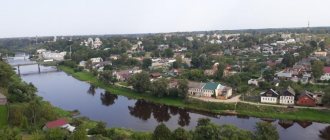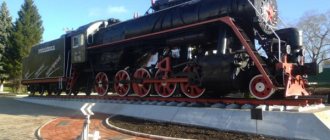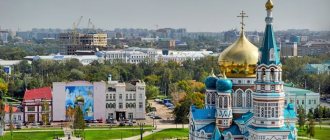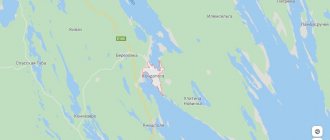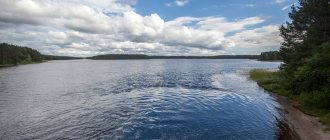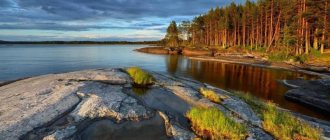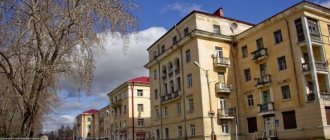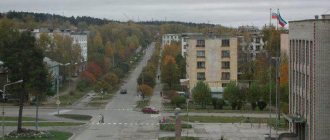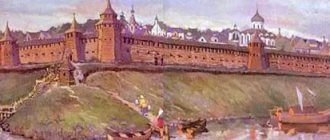People have settled in the lowlands of the Karelian Olonka River since ancient times. According to archaeologists, the first dwellings were built here back in the 2nd millennium BC. The name Olonets comes from the Finnish word alanko─ “lowland”.
These lands were in the possession of the Novgorod ruler for a long time. Wars with Sweden ruined the inhabitants until the Stolbovo Peace Treaty was signed in 1617. The agreement designated a border line 40 kilometers from the Olonets churchyard. Soon a border fortress was erected, the wall of which with 1300 loopholes stretched along the Olonka and Megrega rivers. The fortress had 19 towers, the highest being 32 meters. The fortifications were equipped with 31 cannons. The prison was larger and more powerful than Arkhangelsk.
In the mid-18th century, there was a fire at the fortifications, but restoration no longer made sense. Olonets became not only a military city, but also a trading city. Merchants from Olonets carried goods as far as Stockholm.
Olonets can become an interesting route point on the way to Petrozavodsk, Kizhi Island and other attractions of Lake Onega.
Peter the Great, preparing for the Northern War, built military shipyards and weapons factories here. After the war, the border moved further north, many factories closed, and Olonets became a typical Russian province. The visits of Peter the Great stirred him up somewhat; he repeatedly came for treatment at the local marcial waters.
Under Soviet rule, the city became part of the Autonomous Karelian Republic. During the Finnish War, Olonets was occupied and liberated only in 1944. The city still retains its 18th century layout.
Museum of Karelian-Livviks named after N.T.Prilukin
Address: Uritskogo st., 9 Phone: (81436) 2-13-31 Website: museum.ru/M1244 Opening hours: 10:00-17:00; Sunday: 11:00-15:00; Closed: Saturday Cost: adults: 30 rubles, schoolchildren: 20 rubles
An enthusiastic local historian, Prilukin devoted his entire life to collecting materials about the Livvik Karelians (Olonets Karelians). He managed to collect a large ethnographic collection of rare materials about the culture and life of this subethnic group, for example, items embroidered using the rare poimittu technique.
Based on the collection, the first local history museum in Karelia was opened in 1959. In addition to ethnography, there are other interesting exhibitions here, for example, an exhibition of old New Year's toys. There is a creative workshop teaching ancient Olonets weaving.
The museum occupies the house of the merchant Kuttuev, built in 1872 on the site of the chambers of the Olonetsky governor.
What to see
A remarkable fact for those who visit Olonets is that the sights that reflect the history of the city can be visited in one day.
- The Olonets National Museum of Livvik Karelians is located in the mansion of the merchant V.E. Kuttuev built in the 19th century. Here you can see authentic household items from different eras. The main exhibition tells about the history and culture of the Karelians. There is also a hall dedicated to Olonets.
- The current Cathedral of the Smolensk Icon of the Mother of God stands on the island of Mariam, which is surrounded by two rivers - Olonka and Megrega. The white stone temple of the first half of the 19th century is crowned with emerald-colored domes.
- Pedestrian wooden bridges - the hallmark of the city - are found in the central part, as well as in the surrounding villages.
- In the villages near Olonets there are several wonderful examples of northern temple art: • Assumption Church in the city cemetery; • Chapel of the Archangel Michael, Peter and Paul in the village of Novinka; • Temple of Florus and Laurus in the village of Megrega; • Church of the Holy Image of the Savior in the village of Eroyla.
- The city has several memorials dedicated to heroes who died during the wars of the last century: • monument to the unknown soldier; • a monument to soldiers-liberators in the form of a stele with an anti-tank gun; • mass grave of soldiers and partisans who died during the Second World War; • a memorial at the site of the mass grave of victims of the White Finnish intervention of 1919, as well as Red Army soldiers who died during the liberation of Karelia in 1944; • a monument to military pilots, which is an airplane wing on a concrete pedestal.
Cathedral of the Icon of the Mother of God of Smolensk
Address: st. 30th anniversary of the Victory (Mariam Island) Phone: 89119212084 Opening hours: 9:00-19:00
In the center of Olonets, the Megrenga River and the Olonka River formed a small island. Three bridges lead to it from different sides of the city.
On the picturesque island there is a stone temple, built in 1752 in the classicist style. The temple was built on the site of the wooden church of Hodegetria.
In 1819, Emperor Alexander the First arrived in Olonets. In his travels around Russia, Alexander never missed the opportunity to hold a service in a local church and pray for the well-being of the empire and his subjects. He also went to the Smolensk Cathedral in Olonets. By that time, many years had passed since construction, the temple had never been repaired and fell into disrepair. The emperor was shocked by what he saw and immediately donated a significant amount to repair the temple. The inhabitants of the city did not forget this, and after the death of the king, one of the local merchants managed to obtain a relic - the hearse on which the body of the emperor was transported. This hearse stood in the church until 1917.
The cathedral was closed after 1917. During the Finnish occupation, a Lutheran church was opened here, and in the 70s - a local history museum. Now restoration work has been completed in the church and services are taking place again.
The city of Olonets today
Nowadays, the city of Olonets is the administrative center of the Olonets national district, forming the Olonets urban district.
About 8 thousand people live here. Multi-storey residential buildings are located only in the central part, further from the center there is a low-rise private sector.
The city has a local history museum, an art gallery, a folk theater, a stadium, and an ice skating rink. I operate a dairy plant and a bakery. There are several farms in the vicinity of the city. There is a bus station in the city center, not far from Olonets there is the federal highway P-21 “Kola”.
Church of Frol and Laurus
Address: village Megrega How to get there: along the Petrozavodsk-Olonets highway. A visit must be arranged by calling the Smolensk Cathedral
A unique monument of wooden Novgorod architecture of the early 17th century. The church was built in memory of the war with the Lithuanians. Placed on a hill, it is visible from all sides: its head on an octagonal tent proudly rises among the trees. This is the oldest wooden building in Karelia.
After the victory over the Swedes, temples were erected throughout Rus' in memory of those killed. The Temple of Frol and Laurus was built on the way from Novgorod to the north. Travelers came here to pray for a safe end to their journey. Saints Frol and Laurus patronized agriculture, so the temple was also important for the surrounding peasants.
Inside there is a rarely seen tyablo iconostasis, giving an idea of what the decoration of Russian churches looked like before the 14th century. In the 19th century, the outside of the church was covered with stone. Services are held in the temple.
Video
Video about the city of Olonets from the OTR channel
If you have not yet chosen where you will live and want to save money when booking, we recommend using the RoomGuru service. Firstly, it contains hotels, apartments and guest houses from many different booking systems, so you won’t miss out on a worthwhile option. Secondly, you can immediately compare prices for one place in different services and book where it is cheaper (this is not always Booking!).
Olonets is the oldest settlement in Karelia. For the first time in written sources it is mentioned in the Charter of the Novgorod prince Svyatoslav Olgovich (1327), although some researchers of the Scandinavian sagas associate the city of Alaborg, mentioned in the “Saga of Halfdan, son of Eystein”, with Olonets. Archaeological data indicate that one of the sites of ancient man, discovered in the lower reaches of the Olonka River, where the city is now located, dates back to 3-2 thousand BC.
The city is located in the center of the Olonets Plain - a large, gently sloping lowland gradually descending to Lake Ladoga. The ancient name of Olonets - “Alons” or “Olons”, apparently goes back to the Karelian “alongo”, “alovaine” - lowland, lower reaches.
In 1649, at the confluence of Olonka and Megrega, in a place called Tolmachev Navolok, through the efforts of Prince F. Volkonsky and governor S. Elagin, the border fortress of Olonets was founded, and from that time on, the official countdown of its existence as a city and center of Olonets district began. The latter at that time included the entire territory of South Karelia. The fortress and the surrounding settlement with a population of more than 1000 inhabitants (1707) became a major North Russian trading center, where merchants from both Muscovite Rus' and Sweden conducted business.
At the beginning of the 18th century. Peter the Great visited the city several times on his way to Marcial Waters. The importance of Olonets as a fortress remained until 1721, when the Swedish border was again pushed north. The fortress existed until the middle of the 18th century. and was dismantled due to disrepair and due to the fact that Olonets ceased to play the role of a border outpost of Russia.
After the victorious end of the wars with Sweden by Imperial Russia during the times of Peter the Great and Elizabeth, the strategic importance of the city came to naught, and its commercial and cultural significance decreased. Olonets becomes one of the ordinary district towns.
The merchant class began to play a decisive role in the development of the city. In the XVII-XVIII centuries. Olonets continued to be a major trading center, and by the end of the 18th century. Olonets' trading weight grew due to servicing the rapidly growing St. Petersburg. Olonets merchants supplied the capital with timber, firewood, hay, and craft and agricultural products. To ensure this trade, shipbuilding is developing in the county and private sawmills are being built. Many Olonets merchants moved to St. Petersburg and enrolled in its merchant class.
With the formation of the Olonets province at the end of the 18th century. the center of administrative life of the region moves to Petrozavodsk, and the coat of arms of the city of Olonets becomes the coat of arms of the province. The half-asleep life of a provincial town flows steadily until the revolutionary upheavals of the 20th century.
In 1919, the city experienced a short period of occupation by Finnish troops, and later became a regional center. Agricultural production is developing quite intensively on the arable lands and pastures of the Olonets Plain; it was here in 1930 that the first MTS in Karelia was created.
During the Great Patriotic War, the city was again subjected to a three-year occupation and was liberated by troops of the Karelian Front in the summer of 1944.
Today, it is home to more than 11 thousand residents, mainly engaged in the production and processing of agricultural and livestock products.
The Olonets National Museum named after N. Prilukin has rich collections of authentic objects that, without a doubt, may be of interest to lovers of traditional folk life and art.
The city of Olonets from time to time becomes the object of close attention of the press: the city receives guests. In winter, Santa Clauses compete here at the Olonets Santa Claus Games (December). The annual Olonets Santa Claus Games bring together about twenty Santa Clauses from all over Russia and have already created a new image of the living “real” Santa Claus.
In the spring (May) Olonets meets geese and hosts the ecological festival “Olonia - the Goose Capital” with goose races and children’s games, as well as the water festival “Race along the Olonka”; in the summer during the “Dairy Festival” (August) you can see the “Cow Parade” , in the fall, Olonets glorifies its national traditions and its Karelian language at the Karelian poetry festival “Here is the Beginning of My Motherland” (September) and the national costume festival “Olonets Round Dance” (October).
You can watch a video about the “Olonets geese”
The city is located near the federal highway "Kola", the distance to Petrozavodsk is 140 km, to St. Petersburg - 310 km; a railway line to the Northern Ladoga region passes through Olonets (direct carriages from Petrozavodsk and St. Petersburg); There are regular bus services. Through Olonets you can go to the eastern and northern coasts of Ladoga, famous for its beautiful sandy beaches, fishing, picturesque landscapes, historical monuments and settlements.
Statistical data: City of district subordination (Olonets district, Republic of Karelia) Center: Olonets district, Republic of Karelia Founded: 1137 Deviation from Moscow time, hours: 0 Geographic latitude: 61°02' Geographic longitude: 33°00'
Olonets: areas, recreation, excursions, museums and churches, cuisine and restaurants, shopping and shops, attractions of Olonets.
Olonets is one of the oldest cities in northern Russia. It was first mentioned in historical documents in 1137, and in the mid-17th century. a powerful fortress was built here to protect the city from the invasion of the Swedes. The fortress itself has not survived to this day, but in Olonets the remains of the fortress moat that once surrounded it have been preserved; archaeological work is still underway at this site.
In general, Olonets is better preserved than many other cities in Karelia, but you shouldn’t delude yourself about it and expect too much. In addition to the moat, several merchant houses of the 19th century have been preserved here among the historical attractions, but the most beautiful thing about Olonets is its landscapes: a very picturesque floodplain of two rivers.
Assumption Church
Address: village Kunelitsy (territory of the city cemetery) Opening hours: 10:00-18:00
The temple was erected thanks to the efforts of Empress Catherine the First, who remembered the city where her husband often visited.
The only church that has always been active. This is the merit of the parishioners and especially Natalya Lobskaya, who in the sixties, during another wave of closures of existing churches, went to Moscow with a petition signed by city residents and defended the temple. Then she became a nun.
Night life
Nightlife in Olonets begins in the morning. We found out about this when we came to the city disco in the cinema at one in the morning.
Large hall. Music. Lights. And not a single person.
-Where are all the people? – we asked the saleswoman of the stall with beer and “burn” installed right there in bewilderment.
- They haven’t come yet. “It’s early,” she replied.
- Is it early?! What time do you start dancing?
- They haven’t arrived yet. Later there will be...
We stood there for about ten minutes and went out into the night. Don't wait until two, really!
“You’re funny,” Zhanna later marveled. “Our people are swinging late.” Who will pour them a drink at the disco? Nobody. So they drink at home and then just go for a couple of hours of exercise.
But in the restaurant next to the hotel there were people at one in the morning. True, it is very diverse and also not numerous. Adults, random Finnish tourists mixed in with graduates are quite a sight. In general, we were not able to dance in Olonets.
Church of the Holy Cross Church of Ingria
Address: st. Svirskikh divisions, 12-a Telephone: (81436) 4-21-06 Website: https://cnacaem-uucyc.narod.ru/ Opening hours: 18:00-20:00 - constantly, during other hours according to the schedule of services and events.
A modern church, an example of a typical European Protestant church. This type of church is rare in Russia, especially in the provinces. It is especially interesting to see the differences in the architecture of Orthodox churches and Protestant churches.
Vazheozersky Monastery
Address: Interposelok village Telephone: (81436)2-43-18 Opening hours: 8:00-20:00 How to get there: from St. Petersburg from the bus station on the Obvodny Canal flight: St. Petersburg-Petrozavodsk to the turn to Interposelok, from where another 12 km; or from the Olonets bus station, route: Olonets - Interposelok.
In the 16th century, a monastery was founded by the monks Nikifor and Gennady near Vazhozero. The monks sought peace and solitude in the deep Olonets forests. But people came to them, disciples settled nearby, built hermitages and cells. This is how this monastery appeared.
The Monk Gennady was buried by his followers in the cave where he lived before the construction of the monastery. After his death, the monastery was built and expanded. The dense Karelian forests reliably sheltered her from the bustling outside world. Although the Poles reached here during the Time of Troubles and destroyed the monastery, it was rebuilt again. The events of 1917 did not escape these places. The monastery was closed, its premises were used either as a prisoner of war camp or as a psychiatric hospital.
Now the monastery is being restored, it has again been inhabited by monastic brethren. The relics of St. Gennady were miraculously preserved, as was the holy well. People still come here to venerate the shrines, ask for advice, and explore the ancient monastery.
Interesting Facts
More than half of the population of Olonets and the entire region are Livvik Karelians. Many of them speak their native language, and the signs and some signs here are duplicated in Karelian.
The city's coat of arms, which appeared in 1730, is one of the oldest in the country. A hand with a shield emerging from the clouds symbolizes earthly and divine protection. Two crossed nipples are the city’s contribution to the creation of Russia’s naval power: logging, shipbuilding, casting guns and shells.
Every year at the beginning of winter, the Olonets Santa Claus Games are held here - a fun festival that brings together winter wizards from different regions and countries.
